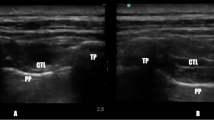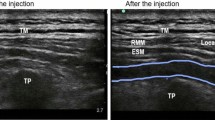Abstract
Purpose
The newly introduced erector spinae plane block (ESPB) has given anesthesiologists an alternative regional anesthetic technique for thoracic analgesia. Although ESPB and retrolaminar block (RLB) have similar puncture sites, no clinical study comparing ESPB and RLB has been reported. The aim of this study was to compare ESPB and RLB in terms of analgesic efficacy in the context of multimodal analgesia following breast surgery.
Methods
Fifty female patients undergoing breast surgery under general anesthesia were randomly allocated to receive either ultrasound-guided ESPB or RLB with 20 mL of 0.375% levobupivacaine for postoperative analgesia. The primary outcome was analgesic efficacy in terms of time to first postoperative rescue analgesic after the block procedure. The secondary outcomes were consumption of remifentanil during anesthesia, pain intensity at rest for 24 h postoperatively, and occurrence of postoperative nausea and vomiting (PONV).
Results
After excluding five patients, 45 patients (22 and 23 patients in the ESPB and RLB group, respectively) were analyzed. Median time until the first postoperative rescue analgesic after the block procedure in the ESPB group was not significantly longer than that in the RLB group (8.6 [range 2.7–24] vs. 4.8 [3.0–24] h; P = 0.83). There was no significant difference in the consumption of remifentanil during anesthesia, pain intensity at rest for 24 h postoperatively, and occurrence of PONV between the two groups.
Conclusion
ESPB is equivalent, and not superior, to RLB for postoperative analgesia after breast surgery when 20 mL of 0.375% levobupivacaine is injected at the fourth thoracic vertebra.



Similar content being viewed by others
References
Gärtner R, Jensen MB, Nielsen J, Ewertz M, Kroman N, Kehlet H. Prevalence of and factors associated with persistent pain following breast cancer surgery. JAMA. 2009;302:1985–92.
Woodworth GE, Ivie RMJ, Nelson SM, Walker CM, Maniker RB. Perioperative breast analgesia: a qualitative review of anatomy and regional techniques. Reg Anesth Pain Med. 2017;42:609–31.
Schnabel A, Reichl SU, Kranke P, Pogatzki-Zahn EM, Zahn PK. Efficacy and safety of paravertebral blocks in breast surgery: a meta-analysis of randomized controlled trials. Br J Anaesth. 2010;105:842–52.
Kulhari S, Bharti N, Bala I, Arora S, Singh G. Efficacy of pectoral nerve block versus thoracic paravertebral block for postoperative analgesia after radical mastectomy: a randomized controlled trial. Br J Anaesth. 2016;117:382–6.
Goswami S, Kundra P, Bhattacharyya J. Pectoral nerve block1 versus modified pectoral nerve block2 for postoperative pain relief in patients undergoing modified radical mastectomy: a randomized clinical trial. Br J Anaesth. 2017;119:830–5.
Moller JF, Nikolajsen L, Rodt SA, Ronning H, Carlsson PS. Thoracic paravertebral block for breast cancer surgery: a randomized double-blind study. Anesth Analg. 2007;105:1848–51.
Murouchi T, Yamakage M. Retrolaminar block: analgesic efficacy and safety evaluation. J Anesth. 2016;30:1003–7.
Forero M, Adhikary SD, Lopez H, Tsui C, Chin KJ. The erector spinae plane block: a novel analgesic technique in thoracic neuropathic pain. Reg Anesth Pain Med. 2016;41:621–7.
Gurkan Y, Aksu C, Kus A, Yorukoglu UH, Kilic CT. Ultrasound guided erector spinae plane block reduces postoperative opioid consumption following breast surgery: a randomized controlled study. J Clin Anesth. 2018;50:65–8.
Yao Y, Li H, He Q, Chen T, Wang Y, Zheng X. Efficacy of ultrasound guided erector spinae plane block on postoperative quality of recovery and analgesia after modified radical mastectomy: randomized controlled trial. Reg Anesth Pain Med. 2020;45:5–9.
Adhikary SD, Bernard S, Lopez H, Chin KJ. Erector spinae plane block versus retrolaminar block: a magnetic resonance imaging and anatomical study. Reg Anesth Pain Med. 2018;43:756–62.
Ivanusic J, Konishi Y, Barrington MJ. A cadaveric study investigating the mechanism of action of erector spinae blockade. Reg Anesth Pain Med. 2018;43:567–71.
Onishi E, Toda N, Kameyama Y, Yamauchi M. Comparison of clinical efficacy and anatomical investigation between retrolaminar block and erector spinae plane block. Biomed Res Int. 2019;2019(28):2578396. https://doi.org/10.1155/2019/2578396.
Yang HM, Choi YJ, Kwon HJ, O J, Cho TH, Kim SH. Comparison of injectate spread and nerve involvement between retrolaminar and erector spinae plane blocks in the thoracic region: a cadaveric study. Anaesthesia. 2018;73:1244–50.
Dautzenberg KHW, Zegers MJ, Bleeker CP, Tan ECTH, Vissers KCP, van Geffen GJ, van der Wal SEI. Unpredictable injectate spread of the erector spinae plane block in human cadavers. Anesth Analg. 2019;129:e163–e166166.
Gad M, Abdelwahab K, Abdallah A, Abdelkhalek M, Abdelaziz M. Ultrasound-guided erector spinae plane block compared to modified pectoral plane block for modified radical mastectomy operations. Anesth Essays Res. 2019;13:334–9.
Seelam S, Nair A, Christopher A, Upputuri O, Naik V, Rayani BK. Efficacy of single-shot ultrasound-guided erector spinae plane block for postoperative analgesia after mastectomy: a randomized controlled study. Saudi J Anaesth. 2020;14:22–7.
Acknowledgements
The authors thank Fukino Satomi for her assistance in perioperative management of the subjects in this study, and the Department of Surgery, Surgical Oncology and Science, Sapporo Medical University School of Medicine, Sapporo, Japan.
Funding
We received only departmental funding for this work.
Author information
Authors and Affiliations
Contributions
All authors contributed to the study conception and design. Data collection and analysis were performed by SS and AS. The first draft of the manuscript was written by AS, and all authors commented on previous versions of the manuscript. All authors read and approved the final manuscript.
Corresponding author
Ethics declarations
Conflict of interest
The authors have no conflict of interest.
Additional information
Publisher's Note
Springer Nature remains neutral with regard to jurisdictional claims in published maps and institutional affiliations.
About this article
Cite this article
Sotome, S., Sawada, A., Wada, A. et al. Erector spinae plane block versus retrolaminar block for postoperative analgesia after breast surgery: a randomized controlled trial. J Anesth 35, 27–34 (2021). https://doi.org/10.1007/s00540-020-02855-y
Received:
Accepted:
Published:
Issue Date:
DOI: https://doi.org/10.1007/s00540-020-02855-y




